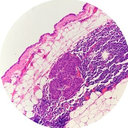Survey of tyrosine kinase signaling reveals ROS kinase fusions in human cholangiocarcinoma.
Słowa kluczowe
Abstrakcyjny
Cholangiocarcinoma, also known as bile duct cancer, is the second most common primary hepatic carcinoma with a median survival of less than 2 years. The molecular mechanisms underlying the development of this disease are not clear. To survey activated tyrosine kinases signaling in cholangiocarcinoma, we employed immunoaffinity profiling coupled to mass spectrometry and identified DDR1, EPHA2, EGFR, and ROS tyrosine kinases, along with over 1,000 tyrosine phosphorylation sites from about 750 different proteins in primary cholangiocarcinoma patients. Furthermore, we confirmed the presence of ROS kinase fusions in 8.7% (2 out of 23) of cholangiocarcinoma patients. Expression of the ROS fusions in 3T3 cells confers transforming ability both in vitro and in vivo, and is responsive to its kinase inhibitor. Our data demonstrate that ROS kinase is a promising candidate for a therapeutic target and for a diagnostic molecular marker in cholangiocarcinoma. The identification of ROS tyrosine kinase fusions in cholangiocarcinoma, along with the presence of other ROS kinase fusions in lung cancer and glioblastoma, suggests that a more broadly based screen for activated ROS kinase in cancer is warranted.



